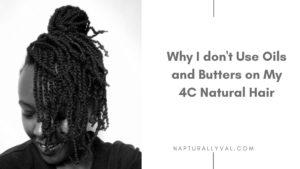If you have 4C natural hair, you know it’s beautiful, versatile, and full of life. But one of the biggest struggles many 4C naturals face is hair breakage. While breakage can feel discouraging, it doesn’t have to be the norm. With the right hair care routine, techniques, and products, you can significantly reduce breakage and help your hair reach its full potential.
In this post, we’ll dive into the secrets of preventing breakage on 4C natural hair. From protective styling and moisture retention to choosing the right products and practicing proper hair care techniques, I’ll share tips to keep your hair healthy, strong, and thriving.
Feel like your hair has been the same length forever, I’ve an Ebook that will help you grow your hair healthier, longer and thicker. Grab your copy here… Also, check out all the Ebooks,guides and journals that will go a long way in your hair care journey here.

Understanding Breakage in 4C Hair
Before we get into the “how,” it’s important to understand the “why.” Breakage happens when your hair is dry, weak, and not properly maintained. For 4C hair, which is more delicate and has a tight curl pattern, this can happen more easily because the hair strands naturally lack moisture. This dryness can lead to breakage, particularly at the ends of the hair, where the hair is oldest and most vulnerable.
Common Causes of Breakage in 4C Hair:
- Dryness: 4C hair tends to be drier than other hair types due to its tight curls. The natural oils from your scalp have a harder time traveling down the hair shaft.
- Manipulation: Constant manipulation, like styling, combing, and touching your hair, can lead to breakage.
- Improper Detangling: Rough detangling methods can cause knots and tangles, leading to breakage.
- Heat Damage: Excessive heat styling can weaken the hair shaft, making it prone to breakage.
- Chemical Damage: Harsh chemicals, such as relaxers, can weaken the hair structure, causing breakage.
- Neglecting Protective Styling: Wearing your hair out all the time without protective styles can expose your ends to breakage.
Now that we know what causes breakage, let’s explore how to prevent it.

Secrets to Preventing Breakage on 4C Natural Hair
1. Moisturize, Moisturize, Moisturize!
Moisture is your best friend when it comes to preventing breakage in 4C hair. Because 4C hair is prone to dryness, it’s essential to keep it moisturized at all times. When your hair lacks moisture, it becomes brittle and more prone to breaking.
Here’s how to keep your hair moisturized:
- Hydrate Daily: Use a water-based leave-in conditioner or spritz your hair with water daily to keep it hydrated.
- LOC or LCO Method: The LOC (Liquid, Oil, Cream) or LCO (Liquid, Cream, Oil) method is a fantastic way to lock in moisture. Start with a water-based leave-in conditioner (liquid), follow with an oil to seal in the moisture, and finish with a cream or butter to further lock it all in.
- Deep Condition regularly: Make deep conditioning a regular habit. Deep conditioners penetrate the hair shaft and provide intense moisture, which helps prevent breakage.
- Moisturize the Ends: The ends of your hair are the oldest and most fragile. Give them extra attention by applying a heavier cream or butter to ensure they’re well moisturized and protected.
2. Low Manipulation and Protective Styling
Constantly handling your hair can lead to unnecessary breakage. That’s why incorporating low-manipulation and protective styling is essential for 4C hair. These styles keep your hair tucked away, reducing the amount of handling and stress placed on the strands.
Low-Manipulation Styles:
- Twists or Braids: Keeping your hair in twists or braids for a few days reduces the need for daily styling and manipulation.
- Buns: A loose, low bun is a great way to keep your hair protected without too much tension on the scalp or edges.
- Box Braids: Box braids protect your ends while allowing your hair to grow with less manipulation.
- Twist Extensions: Just like box braids, twist extensions provide protection and reduce handling of your natural hair.
- Wigs and Weaves: Wearing wigs or weaves can give your hair a break from daily styling, but make sure your hair is properly moisturized and braided underneath.
Key Tip: When wearing protective styles, don’t forget about your hair underneath! Continue moisturizing your scalp and hair while it’s in the style to prevent dryness and breakage when you take it down.
3. Gentle Detangling
One of the biggest causes of breakage in 4C hair is improper detangling. Detangling 4C hair requires patience and the right tools to prevent knots, tangles, and breakage.
How to Detangle Without Breakage:
- Finger Detangle First: Before reaching for a comb, start by finger detangling. This helps to gently separate any major knots or tangles before using a comb or brush.
- Use a Wide-Tooth Comb: When detangling, always use a wide-tooth comb. This helps prevent pulling and breakage.
- Work in Sections: Detangling all of your hair at once can lead to breakage. Instead, work in small sections to make the process more manageable and less damaging.
- Start at the Ends: Always start detangling at the ends of your hair and work your way up to the roots. This helps to minimize breakage.
- Use a Detangler: Applying a detangling product or leave-in conditioner before detangling can make the process much easier and gentler on your strands.

4. Protect Your Hair at Night
How you treat your hair while you sleep can make or break your hair’s health—literally. Cotton pillowcases can cause friction, leading to dryness and breakage, especially for 4C hair. Protecting your hair at night is an easy yet effective way to prevent breakage.
Nighttime Hair Care Tips:
- Satin or Silk Bonnet: Always wear a satin or silk bonnet to bed. These materials are gentle on your hair and help retain moisture.
- Satin or Silk Pillowcase: If you’re not a fan of bonnets, invest in a satin or silk pillowcase. This will reduce friction and help keep your hair moisturized while you sleep.
- Moisturize Before Bed: Apply a light moisturizer or spritz your hair with water before bed to keep your strands hydrated overnight.
- Pineapple Your Hair: For those with longer hair, gather your hair at the top of your head in a loose ponytail or “pineapple” to preserve your curls and reduce friction.
While it might seem counterintuitive to trim your hair to prevent breakage, regular trims are actually essential for maintaining healthy, strong hair. Split ends are more likely to travel up the hair shaft, leading to further breakage. By trimming your ends regularly, you can prevent splits from causing more damage and keep your hair healthy.
How Often to Trim: Aim to trim your hair every 8-12 weeks. You don’t need to take off much, just enough to get rid of any split ends.
6. Minimize Heat Styling
Excessive heat styling can lead to severe breakage, especially for 4C hair, which is more delicate. Heat tools like flat irons and blow dryers can weaken your hair’s protein structure, making it more prone to breakage.
How to Use Heat Safely:
- Limit Heat Use: Try to limit the use of heat tools to once a month or less. The less heat you use, the healthier your hair will be.
- Use a Heat Protectant: Always apply a heat protectant before using any heat tool. Heat protectants create a barrier between your hair and the heat, reducing the risk of damage.
- Opt for Low Heat Settings: When using a blow dryer or flat iron, choose the lowest heat setting that will still give you the results you want. High heat can cause irreversible damage to your strands.

7. Choose Products Wisel
Using the right products can make a huge difference in preventing breakage. Look for products that provide moisture, strengthen your hair, and reduce tangles. Avoid products that contain harsh chemicals, sulfates, or alcohol, as they can strip your hair of moisture, leading to dryness and breakage.
Key Ingredients to Look for:
- Shea Butter: Deeply moisturizing and helps lock in moisture.
- Coconut Oil: Nourishes and strengthens hair, reducing breakage.
- Jojoba Oil: Mimics the natural oils of the scalp, helping to moisturize and protect the hair.
- Aloe Vera: Hydrates and strengthens the hair, promoting elasticity.
- Protein: Protein treatments can help strengthen the hair shaft and reduce breakage, but use protein treatments sparingly to avoid protein overload.
8. Eat a Balanced Diet
Healthy hair starts from the inside out. If you’re not getting the right nutrients, your hair may become weak and prone to breakage. Make sure you’re eating a balanced diet that includes plenty of:
- Protein: Hair is made of a protein called keratin, so it’s important to get enough protein in your diet. Include sources like lean meats, eggs, beans, and nuts.
- Omega-3 Fatty Acids: Omega-3s help keep your hair hydrated and strong. Include sources like salmon, chia seeds, and flaxseeds.
- Vitamins and Minerals: Vitamins like biotin, vitamin A, and vitamin C, as well as minerals like zinc and iron, are essential for healthy hair growth. Eat a variety of fruits, vegetables, and whole grains to get these nutrients.
Preventing breakage in 4C natural hair requires a mix of moisture, gentle handling, and the right products. By incorporating these secrets into your hair care routine, you can reduce breakage, retain length, and keep your hair healthy and strong. Remember, consistency is key. It may take time to see results, but with patience and the right approach, you can achieve the healthy, beautiful hair you deserve.



